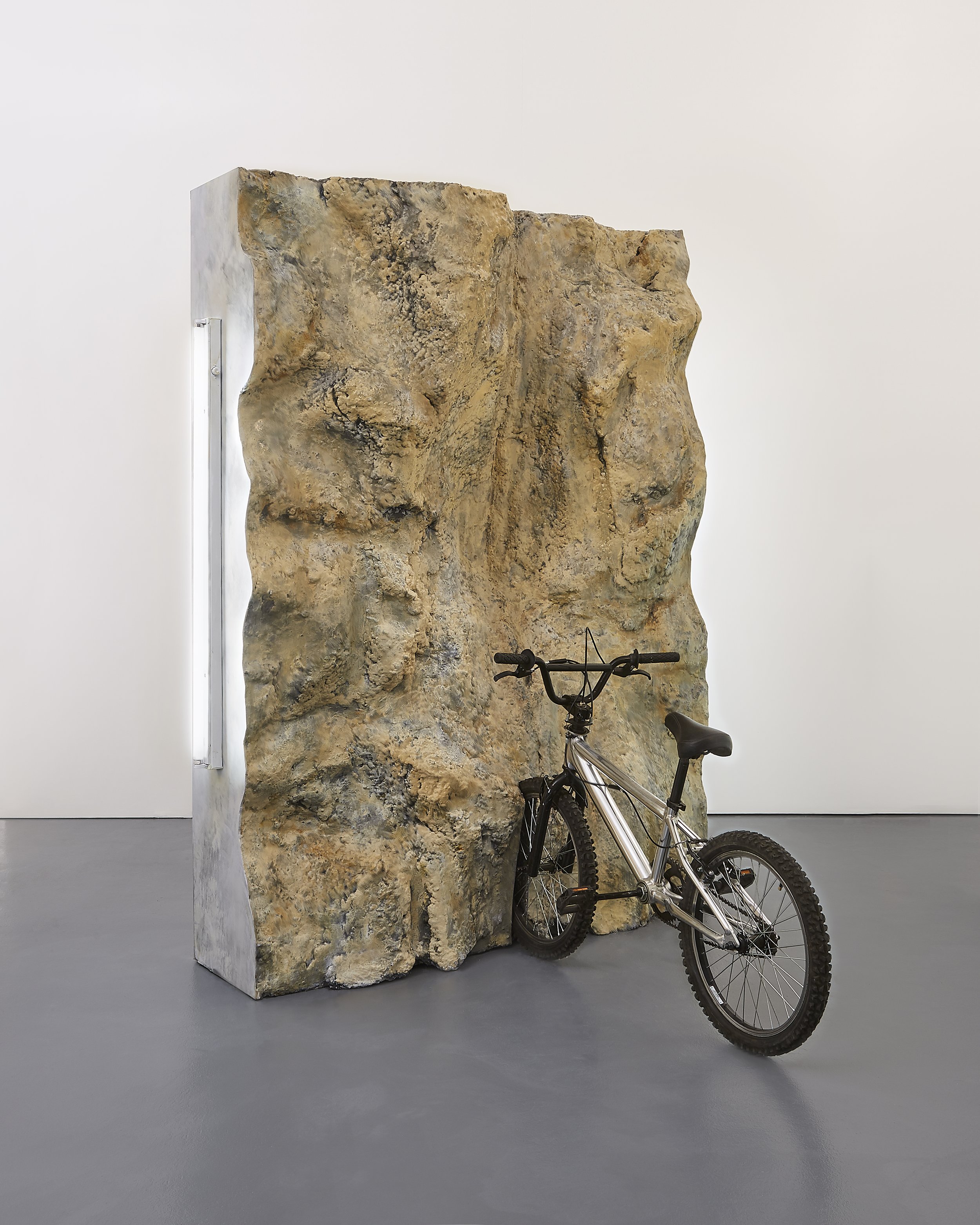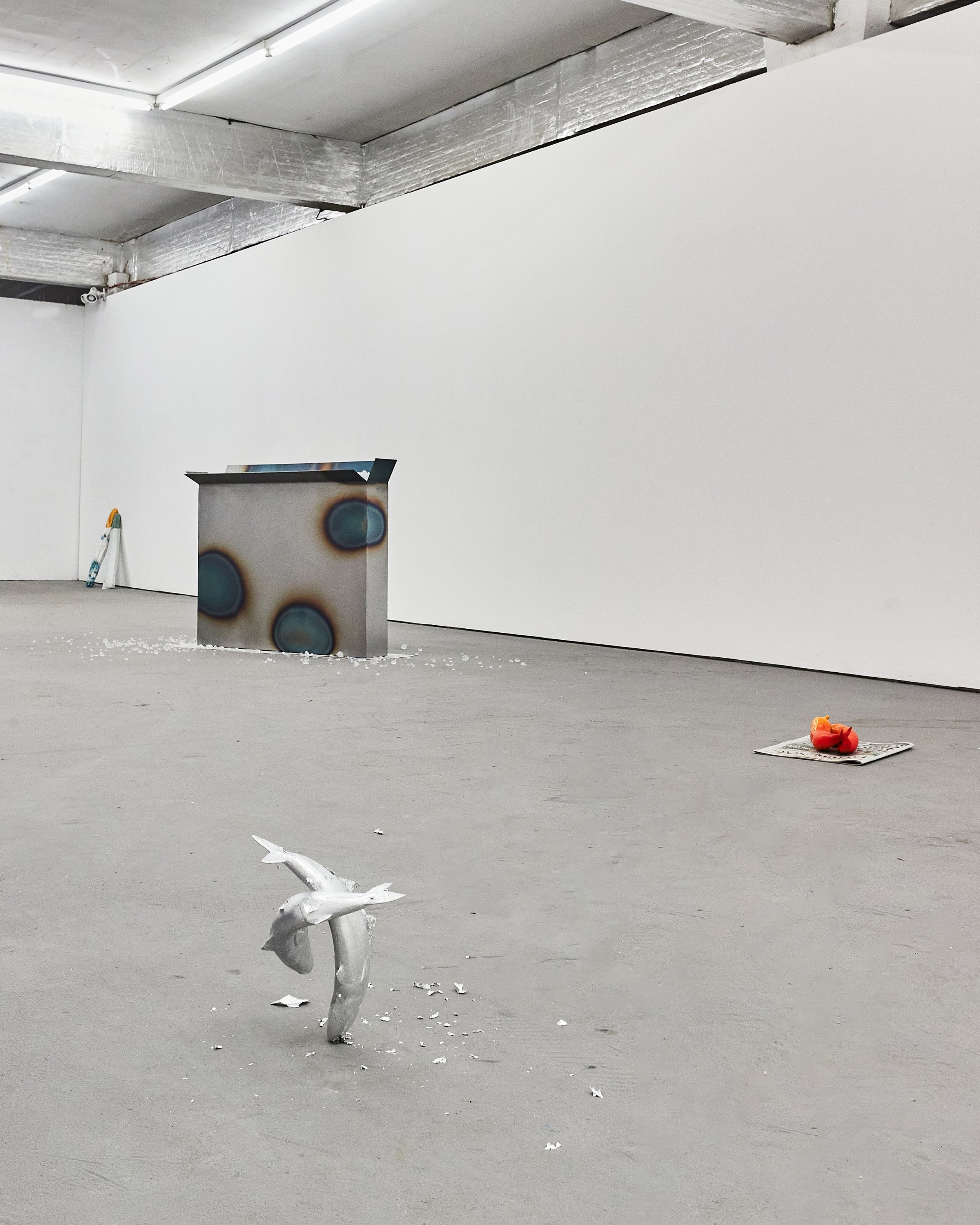Richard Dean Hughes

“The interest in duality started with a collisional approach when making sculpture, I quite naturally began to involve and present very opposite objects and motifs within the one ‘scenario’ or sculpture.”
Interview by Brooke Hailey Hoffert
Could you tell us a bit about yourself and your background? Where did you study?
Yes, well quite ironically I am the son a ‘floor’ layer and I grew up in the no-man’s land of Warrington, right in the middle of Manchester and Liverpool.
I studied Sculpture at Manchester Metropolitan and have lived in different parts of Manchester since graduating. I developed my interest in material by being on or around building sites, working with my dad and brother all the time, I always loved dry concrete and the smooth dust they took of the floors with the grinders, the marks the machines made on the floor and vats of oil and grease on site. I learnt the limitations of resins and coatings laying floors and I still use this knowledge and material in my work to get the finish and structural qualities I need.
Can you expand more on the importance of duality in your practice?
The interest in duality started with a collisional approach when making sculpture, I quite naturally began to involve and present very opposite objects and motifs within the one ‘scenario’ or sculpture. This was then developed by the use of colour and texture to emphasise elemental aspects such as heat and cold, and from there I began to question what actual landscape these sculptures could inhabit or where are they most likely to come from, knowing their new characteristics. The work started to suggest an alternative space or location. From there I think began to become interested in some kind of hybrid functionality within the work, crossing the boundaries of representation and utilitarianism, I began to ask questions of the purpose and perceived function of the work other than these kind of relics or representations of a different place, be it time or location.
I became and still am interested in whether an object can be from 2 places at once or represent 2 places at once and most importantly what this would look like?
Dweller 2019
Death of a Cypress Tree 2021
The fill 2020
Death of a Cypress Tree 2021
What interests you about the relationship between the real and hypothetical?
In some way I guess they are both the same as they both effect the idea of nowness but for me it is a discovery of plausibility which again is linked to duality but to answer your question you have to think about time, objects are manifestations of time and experience, our schematic relationship with an object or material allows it to have its own functionality, momentum and meaning. The relationship of the real object and material allows for an element of storytelling within the work, they become signals to a new ‘hypothetical’ situation. The work in some way becomes a prediction, a representation of the near future.
History is a strong force within my work, I am interested in the fact that the past seems so much more exciting and interesting than the present and what the emotional disparity between past and present looks and feels like. Really a lot of the past is presumed, gathered evidence, of course most events and moments are factual and proven but the aspect of mystery and unsureness simply because we weren’t there ourselves is compelling, so, within my work I began to theoretically and conceptually slice up the time-based elements of an object, be it a bed, a box or a baguette and then hypothetically stitch them back together to create new objects. I treat the concept and history of an object as something that can be manipulated in order to create new scenarios and meaning or plausible meaning. I think a lot of artists are interested in this but I love the idea that the one object can have vastly different interpretations due to it being presented in slightly different ways, it is the consequential thoughts of the viewer that encourage the idea of the ‘hypothetical’ within my work, I simply use suggestive materials and placement within in my work to provoke the continuation of the story, this is when the work is successful for me when it can go backwards and forwards in relation to its own existence and time.
Tell us a bit about how you spend your day / studio routine? What is your studio like?
October last year myself and a group of artists took a big risk and got a large warehouse space in an old Victorian Tram depot in the city. It was empty and we built stud walls and partitioned the space I now have a pretty big space to work and a smaller insulated studio to work in during the winter. We are still doing bits to better the space when we can but more importantly we are all now happily making work, it’s great, I am super lucky and very happy there. The main thing for me is that it’s ground floor with a sliding shutter door so I can already see some of the works and ideas becoming physically bigger, something I have been wanting to do for some time, but the practicality of my old studio just wouldn’t allow. I have started using new materials recently, hand carving extremely dense polyurethane foam, its really heavy but so satisfying to work with and has allowed me to develop an element of ornateness and process within my work.
The approach is so different for each work and in some cases I allow the work to determine the routine, but I mainly get into the studio the absolute maximum amount of time I can, when other aspects of life allow.
How do you go about naming your work?
Basically, I spend a lot of time thinking about what fits and what the atmosphere of the work is suggesting. The title has to be representational of the original concept of the work, but if it can give access to a further narrative then that is great. Sometimes I use quite contrasting words alongside each other, again adding to that aspect of dual meaning. If they sound poetic, then that is an added bonus. Sometimes it is very easy for me to be satisfied and okay with a title and sometimes it can take forever, I guess that it is directly related to the kind of relationship I have with a particular work, its complexity and my sometimes lack of understanding about the work I have made.
Cold Corners 2021
Cold Corners 2021 (Detail)
Subliminal Thaw 2021
Subliminal Thaw, Night Time Story 2021
What artwork have you seen recently that has resonated with you?
Well, recently I included an oil painting as an element within a sculpture so I have been looking at painters more than I ever had and really love the work of Poppy Jones. I did come across an amazing work resembling some kind of solidified vortex by Elaine Cameron Weir, I love how she combines natural forms with industrial material and her Sophisticated use of neon. Also, I recently went to New York and visited Mathew Marks Gallery on West 22nd Street; Robert Gober’s work is on show and I have looked at his work many times before and had never seen the work displayed; these large mild steel wall-based boxes containing everyday but beautiful objects and situations from domestic spaces, like a window opening with curtains blowing and childlike cut-outs of snowflakes on the pane, I loved how severed they were from there natural location and from the predetermined life they probably would have lived.
Is there anything new and exciting in the pipeline you would like to tell us about?
At the minute I am working on 6 new works, I am coming across a lot of first times working with engineers and using a lot of their very clever software and programmes to create work. Recently I have been using stereolithography to create some really interesting shifting forms. I seem to be taking longer to make works but feel better for it. Also like I said earlier, carving! I wanted to incorporate an element of therapy into my practice, something that will allow me to slow down and really understand the object and image that I am interested in, carving large objects with small tools has allowed me to do this, I love how every action has a consequence and leads onto the next decision, it’s a really good way to really understand the formal elements of the object I am representing. Whilst carving fluid and undulating fabric the forms and the sculpture in general really seem to reveal themselves, I am really enjoying this experience at the moment. I am working on a duo show in London next year so hope to a solid body of works complete.
All images are courtesy of the artist
Date of publication: 18/02/22







